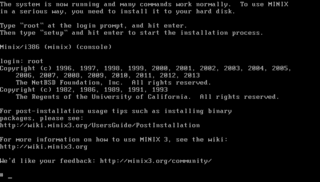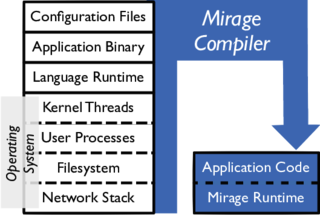
Andrew Stuart Tanenbaum, sometimes referred to by the handle AST, is an American-born Dutch computer scientist and retired professor emeritus of computer science at the Vrije Universiteit Amsterdam in the Netherlands.

In computing and in systems theory, first in, first out, acronymized as FIFO, is a method for organizing the manipulation of a data structure where the oldest (first) entry, or "head" of the queue, is processed first.

MINIX is a Unix-like operating system based on a microkernel architecture, first released in 1987 and written by American-Dutch computer scientist Andrew S. Tanenbaum. It was designed as a clone of the Unix operating system and one that could run on affordable, Intel 8086 based home computers; MINIX was targeted for use in classrooms by computer science students at universities.

In computer science, a microkernel is the near-minimum amount of software that can provide the mechanisms needed to implement an operating system (OS). These mechanisms include low-level address space management, thread management, and inter-process communication (IPC).

An operating system (OS) is system software that manages computer hardware and software resources, and provides common services for computer programs.
In software engineering, porting is the process of adapting software for the purpose of achieving some form of execution in a computing environment that is different from the one that a given program was originally designed for. The term is also used when software/hardware is changed to make them usable in different environments.

USENIX is an American 501(c)(3) nonprofit membership organization based in Berkeley, California and founded in 1975 that supports advanced computing systems, operating system (OS), and computer networking research. It organizes several conferences in these fields.
Amoeba is a distributed operating system developed by Andrew S. Tanenbaum and others at the Vrije Universiteit Amsterdam. The aim of the Amoeba project was to build a timesharing system that makes an entire network of computers appear to the user as a single machine. Development at the Vrije Universiteit was stopped: the source code of the latest version (5.3) was last modified on 30 July 1996.

The Alexis de Tocqueville Institution (AdTI) was a Washington, D.C.–based think tank.
Samizdat: And Other Issues Regarding the 'Source' of Open Source Code is a 2004 report by Kenneth Brown. The report suggests that the Linux kernel may have been created or distributed illegally and that open-source software may be generally subject to such abuses.
The Minix file system is the native file system of the Minix operating system. It was written from scratch by Andrew S. Tanenbaum in the 1980s and aimed to replicate the structure of the Unix File System while omitting complex features, and was intended to be a teaching aid. It largely fell out of favour among Linux users by 1994 due to the popularity of other filesystems - most notably ext2 - and its lack of features, including limited partition sizes and filename length limits.

The Tanenbaum–Torvalds debate was a written debate over the Internet between Andrew S. Tanenbaum and Linus Torvalds, regarding the Linux kernel and kernel architecture in general. Tanenbaum, the creator of Minix, began the debate in 1992 on the Usenet discussion group comp.os.minix, arguing that microkernels are superior to monolithic kernels and therefore Linux was, even in 1992, obsolete. The debate has sometimes been considered a flame war.

Minix 3 is a small, Unix-like operating system. It is published under a BSD-3-Clause license and is a successor project to the earlier versions, Minix 1 and 2.
Linux began in 1991 as a personal project by Finnish student Linus Torvalds to create a new free operating system kernel. The resulting Linux kernel has been marked by constant growth throughout its history. Since the initial release of its source code in 1991, it has grown from a small number of C files under a license prohibiting commercial distribution to the 4.15 version in 2018 with more than 23.3 million lines of source code, not counting comments, under the GNU General Public License v2 with a syscall exception meaning anything that uses the kernel via system calls are not subject to the GNU GPL.

A process is a program in execution, and an integral part of any modern-day operating system (OS). The OS must allocate resources to processes, enable processes to share and exchange information, protect the resources of each process from other processes and enable synchronization among processes. To meet these requirements, The OS must maintain a data structure for each process, which describes the state and resource ownership of that process, and which enables the operating system to exert control over each process.

Operating Systems: Design and Implementation is a computer science textbook written by Andrew S. Tanenbaum, with help from Albert S. Woodhull. The book describes the principles of operating systems and demonstrates their application in the source code of Tanenbaum's MINIX, a free Unix-like operating system designed for teaching purposes. The publisher is Prentice Hall (1987). The source code for MINIX was included as part of the original 719 pages of text. Later versions of the three editions also included loadable disks with MINIX.

A kernel is a computer program at the core of a computer's operating system that always has complete control over everything in the system. The kernel is also responsible for preventing and mitigating conflicts between different processes. It is the portion of the operating system code that is always resident in memory and facilitates interactions between hardware and software components. A full kernel controls all hardware resources via device drivers, arbitrates conflicts between processes concerning such resources, and optimizes the utilization of common resources e.g. CPU & cache usage, file systems, and network sockets. On most systems, the kernel is one of the first programs loaded on startup. It handles the rest of startup as well as memory, peripherals, and input/output (I/O) requests from software, translating them into data-processing instructions for the central processing unit.
A distributed operating system is system software over a collection of independent software, networked, communicating, and physically separate computational nodes. They handle jobs which are serviced by multiple CPUs. Each individual node holds a specific software subset of the global aggregate operating system. Each subset is a composite of two distinct service provisioners. The first is a ubiquitous minimal kernel, or microkernel, that directly controls that node's hardware. Second is a higher-level collection of system management components that coordinate the node's individual and collaborative activities. These components abstract microkernel functions and support user applications.

A unikernel is a type of computer program that is statically linked with the operating system code on which it depends. Unikernels are built with a specialized compiler that identifies the operating system services that a program uses and links it with one or more library operating systems that provide them. Such a program requires no separate operating system and can run instead as the guest of a hypervisor.










